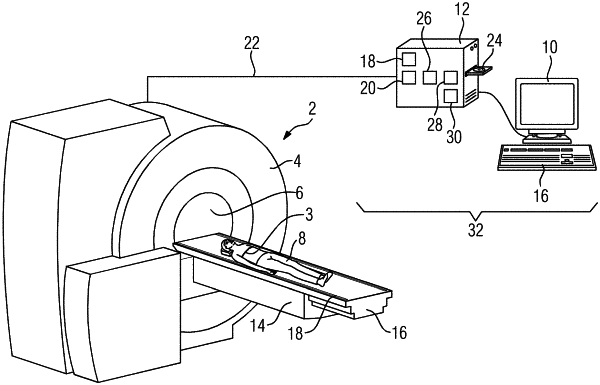| CPC A61B 5/7292 (2013.01) [A61B 5/055 (2013.01); A61B 5/113 (2013.01); A61B 5/7285 (2013.01); A61B 5/7289 (2013.01); A61B 5/742 (2013.01); G01R 33/5673 (2013.01)] | 18 Claims |

|
1. A method for monitoring a current respiratory curve of a patient comprising at least one recording region configured to be imaged by magnetic resonance scanning, the method comprising:
acquiring a reference respiratory curve of the patient over a plurality of respiratory cycles, wherein the reference respiratory curve follows or is followed by the current respiratory curve;
establishing a respiration state of the patient suitable for the magnetic resonance scanning based on the reference respiratory curve;
determining at least one reference recording time window and a trigger threshold value for starting a magnetic resonance scan based on the established respiration state, wherein the magnetic resonance scan is configured to measure the current respiratory curve, and wherein the trigger threshold value corresponds to a value of the reference respiratory curve at a start point of the at least one reference recording time window;
carrying out the magnetic resonance scan within the determined at least one reference recording time window of the current respiratory curve using the trigger threshold value;
continually further acquiring and monitoring the current respiratory curve during the magnetic resonance scan in the determined at least one reference recording time window;
identifying that: (1) a current value of the current respiratory curve does not reach the trigger threshold value over a respiratory cycle, and/or (2) a deviation between at least one parameter of the current respiratory curve and a corresponding parameter of the reference respiratory curve is greater than a first tolerance threshold value; and
repeating the acquiring of a new reference respiratory curve, the establishing of a new respiration state of the patient, and the determining of at least one new reference recording time window and a new trigger threshold value based on the identifying that (1) the current value of the current respiratory curve does not reach the trigger threshold value over the respiratory cycle, and/or (2) the deviation between the at least one parameter of the current respiratory curve and the corresponding parameter of the reference respiratory curve is greater than the first tolerance threshold value.
|